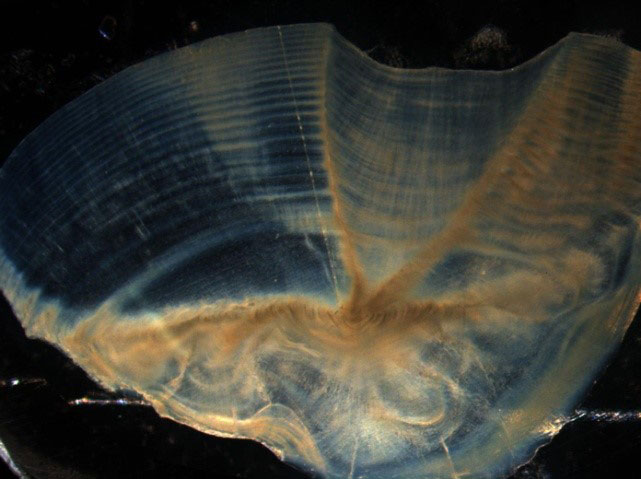Fish Movement and Habitat Use
Project Leader: Reid Nelson, Ph.D. Student
Project Details
Retrospective tracking of fish movement and habitat use
Background:
The otolith, or fish ear bone, is a stone like structure in the head of a fish mainly composed of calcium carbonate (CaCO3) (Figure1). It is a fish sensory structure that aids in orientation and detection of vibrations. It grows continuously throughout the life of a fish laying down annual rings that can be used to age a fish similar to tree aging. As a fish grows new material is deposited into the CaCO3 otolith matrix, and trace elements from the surrounding environment are incorporated into the otolith. Unlike bone or tissue, which can be reabsorbed and reworked through metabolic processes in the fish, otoliths are metabolically inert, meaning that once trace elements are incorporated into the otolith they remain locked in the otolith structure throughout the life of a fish. Given this, retrospective tracking of fish movements, especially across salinity gradients is possible and determination of what age a fish experienced certain habitats is also possible. Estuarine obligate species use a variety of different water bodies with varying salinities throughout their lives and using laser ablation otolith microchemistry these age-dependent patterns of estuary use can be reconstructed. Knowing what habitats fish use and making sure these habitats remain viable and available is essential to the success of a fishery.

Objectives:
The objectives of this project are to (1) determine the timing, duration, and variability of estuarine residence of Red Drum (Sciaenops ocellatus), (2) identify different population contingents based on differing estuary use, (3) determine if certain salinities provide better growing conditions than others, (4) determine if one life history strategy is more successful than another contributing more recruits to the adult fishery, and (5) expand these techniques to other fish and possibly elasmobranch species.
Approach:
Laser ablation inductively coupled plasma mass spectrometry (LA-ICP-MS) is a technique which uses a laser to ablate material and carry it to a mass spectrometer via an inert gas (e.g. Argon). First developed for mineral analysis this technique has become quite popular in otolith analysis, given that the laser allows for chemical analysis in precise locations. This provides a great advantage over solution based mass spectrometry by allowing the correlation of fish age with trace elements experienced at that age. Based on concentrations of certain trace elements (e.g. Sr and Ba) at a given age it is possible to determine if a fish was in freshwater or saltwater, the duration of time spent in this habitat, and the point or points in a fish’s life that movements between these habitats occurred. This preliminary work will be one aspect of a graduate dissertation project that will improve our understanding of the ecology and movements of these estuarine dependent fishes.
